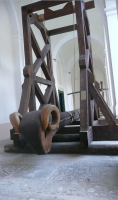A battering ram is a siege engine originating in ancient times and designed to break open the masonry walls of fortifications or splinter their wooden gates.
During the Iron Age, in the ancient Middle East and Mediterranean, the battering ram's log was slung from a wheeled frame by ropes or chains so that it could be made more massive and be more easily bashed against its target. Frequently, the ram's point would be reinforced with a metal head or cap while vulnerable parts of the shaft were bound with strengthening metal bands. Vitruvius details in his text On Architecture that Ceras the Carthaginian was the first to make a ram with a wooden base with wheels and a wooden superstructure. Within this the ram was hung so that it could be used against the wall. This structure moved so slowly, however, that he called it the testudo (the Latin word for ""tortoise"").
Another type of ram was one that maintained the normal shape and structure, but the support beams were instead made of saplings that were lashed together. The frame was then covered in hides as normal to defend from fire. The only solid beam present was the actual ram that was hung from the frame. The frame itself was so light that it could be carried on the shoulders of the men transporting the ram, and the same men could beat the ram against the wall when they reached it.
Many battering rams possessed curved or slanted wooden roofs and side-screens covered in protective materials, usually fresh wet hides, presumably skinned from animals eaten by the besiegers. These hide canopies stopped the ram from being set on fire. They also safeguarded the operators of the ram against arrow and spear volleys launched from above.
A well-known image of an Assyrian battering ram depicts how sophisticated attacking and defensive practices had become by the 9th century BC. The defenders of a town wall are trying to set the ram alight with torches and have also put a chain under it. The attackers are trying to pull on the chain to free the ram, while the aforementioned wet hides on the canopy provide protection against the flames.
Battering rams still have a use in modern times. SWAT teams and other police forces often employ small, one-man or two-man metal rams (sometimes euphemistically referred to as an ""Ovendon door key"") for forcing open locked portals or effecting a door breaching. Modern battering rams sometimes incorporate a cylinder, along the length of which a piston fires automatically upon striking a hard object, thus enhancing the momentum of the impact significantly.








